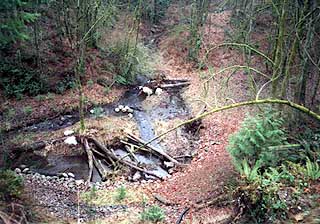
Surveys
DJC.COM
July 12, 2001
Muddy waters: The new 4(d) salmon rule
Shannon & Wilson
The “4(d) rule” that became effective on Jan. 8, 2001, does little to clear up the muddy waters surrounding Puget Sound chinook salmon.

Casne |
Newly adopted by the National Marine Fisheries Service (NMFS), the 4(d) rule contains exemptions that allow incidental “take” of Chinook salmon, which were listed as threatened under the Endangered Species Act in March 1999. “Take” is defined as killing, shooting, harassing, harming or otherwise degrading salmon habitat — all of which were previously stringently prohibited.
To a salmon, these changes might appear contradictory and hard to understand. Indeed, they seem that way even to experts on both sides of the regulatory fence. To further confuse the issue, local jurisdictions including King County and many nearby cities may soon implement new ordinances themselves to protect salmon habitat as a result of 4(d). Thus architects, engineers and developers would be well advised to learn about the rule and its fallout, and investigate salmon-friendly design and construction provisions at every level to ensure project success.

Photo courtesy of Shannon & Wilson Shannon & Wilson restored this section of May Creek by adding logs, stabilizing banks and planting willows to create better fish habitat. |
Of the 13 provisions in the 4(d) rule, one has important ramifications for Puget Sound businesses. This is the Municipal, Residential, Commercial and Industrial Development and Redevelopment (MRCI or “mercy”) rule, which outlines numerous conditions local jurisdictions must meet if they want an exemption.
MRCI permits incidental take of salmon if ordinances require development to:
- Avoid critical areas
- Prevent stormwater discharge impacts
- Protect riparian areas
- Minimize stream crossing impacts
- Protect historic stream patterns
- Protect wetlands and their buffers
- Preserve peak flows in streams
- Landscape with native vegetation
- Prevent erosion and sediment runoff
- Ensure water supply is met without impacting salmon
- Provide monitoring and maintenance
- Comply with other state and federal laws
The lowdown on the MRCI rule is this. If you can prove in advance that you’re taking care of salmon and their habitat, you can go ahead and build — without risking litigation from federal authorities. Given the costs and difficulties of a protracted federal case, this is a very attractive proposition. Jurisdictions can submit proposals to NMFS, detailing how they meet all of the MRCI criteria.
King, Snohomish and Pierce counties have banded together in a regional effort to win MRCI approval. Their Tri-County Model 4(d) Rule Proposal has been in the works for months, and will be submitted to NMFS for review at any time. It takes advantage of numerous salmon-related regulations that were already on the books, such as provisions in the Growth Management Act, local sensitive and critical areas ordinances, and NPDES permits under the Clean Water Act. The proposal addresses road maintenance, stormwater management, management (buffer) zones, Water Resource Inventory Area (WRIA) planning, adaptive management and monitoring and habitat funding.
If the model is approved by NMFS, development as usual will be a thing of the past in Puget Sound. Every project will require some sort of biological review to determine if salmon habitat is being sufficiently protected.
Tangled technicalities
Don’t jump to the conclusion everything will suddenly become simplified, however. There’s a snag with rule 4(d) protection — namely that participation is optional. Local jurisdictions get to decide whether they want to go along with programs being developed by counties or anyone else. And some cities and counties in our region will no doubt say, “No, thanks.” The result could be that each jurisdiction ends up with a different set of rules to protect salmon. Imagine the permitting dilemmas.
Why would jurisdictions pass up the tri-county ready-made package? The answer could involve anything from redundancies, fears of over-regulation and local economics to city-specific habitat risks. Each municipality already has its own ordinances governing critical areas, including salmon habitat. It may therefore make sense to pick and choose among elements in the tri-county proposal, crafting a solution that meets a city or county’s unique needs.
Hurry up and wait
Anyone trying to navigate among different layers of regulations needs to beware. The trip will take a lot longer than in the past.
A possible scenario could go like this. A developer assumes his project will not be impacted by the Endangered Species Act, being located more than a mile from the nearest salmon stream. However, as the development plans proceed, the engineer discovers stringent city restrictions on erosion and sediment control and stormwater treatment. Obtaining city permitting proves to be a nightmare, causing the contractor to miss the dry summer months — the only time when the city allows construction. Construction is delayed until next year, bumping up project costs and aggravating owners.
Tell it to the judge
Developers may also be surprised to learn that 4(d) protection does not decrease your vulnerability to attack from environmental groups or other concerned individuals. All it does is protect you from federal suits. Anybody else can still take exception to your project, accuse you of “taking” salmon and drag you through a lengthy lawsuit.
The NMFS may come to your defense. But again, they may not. Without provisions for legal defense in your schedule, costly delays could derail the entire project.
Salmon-savvy strategies
Dealing with the 4(d) rule is going to take some patience and forward thinking on everyone’s part. If you are planning a project in Western Washington in the near future, consider these suggestions.
Hire a fish biologist early. You’ll need professional advice to find the simplest and safest way through the regulatory morass. Having a biologist on your team from the outset will save both time and money. The biologist should be able to suggest designs and techniques that reduce impacts on salmon habitat.
Expect lots of delays. Even agency employees aren’t certain how the 4(d) rule will shake out in the long run. Municipalities haven’t ironed out their approaches either. So plan for the worst. If you want to build in the summer of 2002, you should have applied for permits in June 2001. You’re already late.
Be salmon-friendly. Be extremely diligent with temporary erosion and sediment control. Adopt best management practices, keeping backhoes out of streams, fueling equipment away from waterways, and marking off staging and work areas with orange fences. Think about secondary impacts of your project, such as stormwater. Can you reduce the amount of impervious surface? Anticipate lots of salmon-related questions, and prepare credible, thoughtful answers about your design.
Life will not necessarily go more swimmingly for either fish or people now that we have the 4(d) rule. Instead, 4(d) merely gives more leeway to localities doing a good job of salmon protection. They also receive NMFS assurance of meeting the intent of the ESA, and are thus not subject to federal litigation.
But 4(d) is no excuse for complacency. Salmon still have their rights. We must be as concerned as ever about their welfare and continued existence. And while the 4(d) rule will transform the way we think about developmental impacts, it will also help us remember that future generations of salmon — and people — require good clean water. None of us can survive without it!
Sam Casne leads the Natural Resources Group at Shannon & Wilson, a Seattle-based environmental and geotechnical consulting firm. More information can be obtained from the company’s Web site: www.shannonwilson.com.
Other Stories:
- Pesticide-free parks teach new lessons
- Water metering: the debate trickles on
- Studies sniff out Tacoma smelter plume
- Tree investment brings cities many happy returns
- From wood preservation to site remediation — the Cascade Pole cleanup
- New rules for birds, bogs and bulldozers
- Isolated wetlands ruling creates confusion
- Environmental metamorphosis on the Duwamish
- Mitigation banks balance habitat, development
- New Pin Foundation minimizes site impacts
- Bringing a city stream back to life
- Knitting a trail of green
- Stormwater problems? Put a LID on it
- More brownfield incentives in the pipeline
- SEPA document trends since GMA and regulatory reform
- Construction faces new foe: toxic mold
- Helping environmental groups to get wired
- Frequently asked ESA questions
- Global climate change starts at home
- At EPA, next 4 years won’t be boring
- Dams vs. fish? Mediate it!
- 'House calls' help firms to conserve
- Building a greener future on Bainbridge
- Power users, producers turn toward the sun
- Seattle goes climate neutral
- Bamboo’s popularity shoots up
- Tiny town recycles Goliath proportions
- MTCA revisions take effect Aug. 15
- Environmental education: Knowing what’s in your backyard
- Bear Creek roars again
- Shedding light into the permit ‘black hole’
- UW Bothell — a wetland lesson in the making
Copyright ©2009 Seattle Daily Journal and DJC.COM.
Comments? Questions? Contact us.